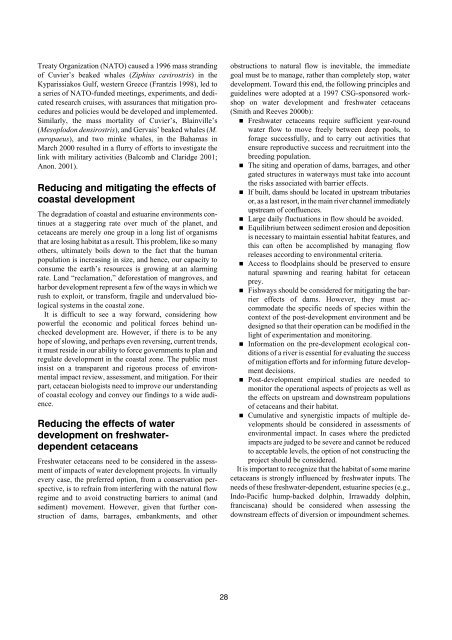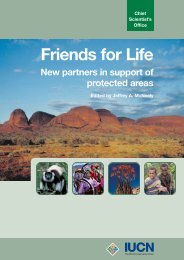Dolphins, Whales and Porpoises: 2002-2010 Conservation - IUCN
Dolphins, Whales and Porpoises: 2002-2010 Conservation - IUCN
Dolphins, Whales and Porpoises: 2002-2010 Conservation - IUCN
You also want an ePaper? Increase the reach of your titles
YUMPU automatically turns print PDFs into web optimized ePapers that Google loves.
Treaty Organization (NATO) caused a 1996 mass str<strong>and</strong>ing<br />
of Cuvier’s beaked whales (Ziphius cavirostris) in the<br />
Kyparissiakos Gulf, western Greece (Frantzis 1998), led to<br />
a series of NATO-funded meetings, experiments, <strong>and</strong> dedicated<br />
research cruises, with assurances that mitigation procedures<br />
<strong>and</strong> policies would be developed <strong>and</strong> implemented.<br />
Similarly, the mass mortality of Cuvier’s, Blainville’s<br />
(Mesoplodon densirostris), <strong>and</strong> Gervais’ beaked whales (M.<br />
europaeus), <strong>and</strong> two minke whales, in the Bahamas in<br />
March 2000 resulted in a flurry of efforts to investigate the<br />
link with military activities (Balcomb <strong>and</strong> Claridge 2001;<br />
Anon. 2001).<br />
Reducing <strong>and</strong> mitigating the effects of<br />
coastal development<br />
The degradation of coastal <strong>and</strong> estuarine environments continues<br />
at a staggering rate over much of the planet, <strong>and</strong><br />
cetaceans are merely one group in a long list of organisms<br />
that are losing habitat as a result. This problem, like so many<br />
others, ultimately boils down to the fact that the human<br />
population is increasing in size, <strong>and</strong> hence, our capacity to<br />
consume the earth’s resources is growing at an alarming<br />
rate. L<strong>and</strong> “reclamation,” deforestation of mangroves, <strong>and</strong><br />
harbor development represent a few of the ways in which we<br />
rush to exploit, or transform, fragile <strong>and</strong> undervalued biological<br />
systems in the coastal zone.<br />
It is difficult to see a way forward, considering how<br />
powerful the economic <strong>and</strong> political forces behind unchecked<br />
development are. However, if there is to be any<br />
hope of slowing, <strong>and</strong> perhaps even reversing, current trends,<br />
it must reside in our ability to force governments to plan <strong>and</strong><br />
regulate development in the coastal zone. The public must<br />
insist on a transparent <strong>and</strong> rigorous process of environmental<br />
impact review, assessment, <strong>and</strong> mitigation. For their<br />
part, cetacean biologists need to improve our underst<strong>and</strong>ing<br />
of coastal ecology <strong>and</strong> convey our findings to a wide audience.<br />
Reducing the effects of water<br />
development on freshwaterdependent<br />
cetaceans<br />
Freshwater cetaceans need to be considered in the assessment<br />
of impacts of water development projects. In virtually<br />
every case, the preferred option, from a conservation perspective,<br />
is to refrain from interfering with the natural flow<br />
regime <strong>and</strong> to avoid constructing barriers to animal (<strong>and</strong><br />
sediment) movement. However, given that further construction<br />
of dams, barrages, embankments, <strong>and</strong> other<br />
28<br />
obstructions to natural flow is inevitable, the immediate<br />
goal must be to manage, rather than completely stop, water<br />
development. Toward this end, the following principles <strong>and</strong><br />
guidelines were adopted at a 1997 CSG-sponsored workshop<br />
on water development <strong>and</strong> freshwater cetaceans<br />
(Smith <strong>and</strong> Reeves 2000b):<br />
� Freshwater cetaceans require sufficient year-round<br />
water flow to move freely between deep pools, to<br />
forage successfully, <strong>and</strong> to carry out activities that<br />
ensure reproductive success <strong>and</strong> recruitment into the<br />
breeding population.<br />
� The siting <strong>and</strong> operation of dams, barrages, <strong>and</strong> other<br />
gated structures in waterways must take into account<br />
the risks associated with barrier effects.<br />
� If built, dams should be located in upstream tributaries<br />
or, as a last resort, in the main river channel immediately<br />
upstream of confluences.<br />
� Large daily fluctuations in flow should be avoided.<br />
� Equilibrium between sediment erosion <strong>and</strong> deposition<br />
is necessary to maintain essential habitat features, <strong>and</strong><br />
this can often be accomplished by managing flow<br />
releases according to environmental criteria.<br />
� Access to floodplains should be preserved to ensure<br />
natural spawning <strong>and</strong> rearing habitat for cetacean<br />
prey.<br />
� Fishways should be considered for mitigating the barrier<br />
effects of dams. However, they must accommodate<br />
the specific needs of species within the<br />
context of the post-development environment <strong>and</strong> be<br />
designed so that their operation can be modified in the<br />
light of experimentation <strong>and</strong> monitoring.<br />
� Information on the pre-development ecological conditions<br />
of a river is essential for evaluating the success<br />
of mitigation efforts <strong>and</strong> for informing future development<br />
decisions.<br />
� Post-development empirical studies are needed to<br />
monitor the operational aspects of projects as well as<br />
the effects on upstream <strong>and</strong> downstream populations<br />
of cetaceans <strong>and</strong> their habitat.<br />
� Cumulative <strong>and</strong> synergistic impacts of multiple developments<br />
should be considered in assessments of<br />
environmental impact. In cases where the predicted<br />
impacts are judged to be severe <strong>and</strong> cannot be reduced<br />
to acceptable levels, the option of not constructing the<br />
project should be considered.<br />
It is important to recognize that the habitat of some marine<br />
cetaceans is strongly influenced by freshwater inputs. The<br />
needs of these freshwater-dependent, estuarine species (e.g.,<br />
Indo-Pacific hump-backed dolphin, Irrawaddy dolphin,<br />
franciscana) should be considered when assessing the<br />
downstream effects of diversion or impoundment schemes.






